1. Indian Pariah Dog

Life Expectancy: 14-16 Years
Suitable for Indian Climate: Yes
Height: 20-25 inches
Weight: 20-30 kilograms
The Indian pariah dog has been in India for 6,000 years or more, long enough for the various Indian languages to develop their own terminology. They can tolerate India’s wide range of climates.
Because they have spent millennia adapting to local diseases, these dogs have highly resilient immune systems. These canines are lively, sociable, and versatile, making them excellent companions for any Indian household.
The double coat of Indian Pariahs covers a medium-built body, with the undercoat being much softer than the coarse upper coat.
Indian Pariahs have minimal to no requirements when it comes to grooming. These dogs have short fur and don’t require constant brushing or combing because they shed relatively little hair.
2. Rajapalayam Dog

Life Expectancy: 14-15 years
Suitable for Indian Climate: Yes
Height: 24-26 inches
Weight: 20-25 kg
The breed got its name in honor of the city of Rajapalayam, from which its distribution began. In appearance, the dog resembles a cross between a greyhound and a Great Dane.
It is obedient and loyal to its owner. She knows how to be grateful for care but is very reserved in her feelings, so you should not expect a dog to be overly affectionate.
The Rajapalayam dog has excellent guard qualities. They categorically do not tolerate strangers and are prone to aggression.
The breed needs socialization training from an early age.
Rajapalayam does not require serious care. It is enough to bathe once every 3 months, comb twice a week, and monitor the cleanliness of the ears, teeth, and eyes.
Special nutrition is also not required, although breeders recommend feeding the dog porridge with meat.
3. Indian Spitz

Life Expectancy: 12-15 Years
Suitable for Indian Climate: Yes
Height: 13-15 Inches
Weight: 15-20 Kilograms
The Spitz was initially introduced to India in the 19th century by the British, who were then in power. Many people choose to keep Spitz dogs as pets because of their beautiful appearance, attributed to their long, thick, and velvety fur coats.
Sometimes, at birth, Indian Spitz puppies have floppy ears, but as they grow older, they become high and sharp. Their fluffy, long tail falls gracefully over their back.
This small breed is full of liveliness and vitality. Not only can they read emotional cues very well, but they also become aroused readily, which facilitates communication.
They are happy, devoted, and loving toward their owners. The Indian Spitz may surprise you with its flexibility. They can get along with kids, adults, and animals because they are intelligent, quick learners.
Their diet should be high in vitamins, calcium, fatty acids, protein, and glucose.
Due to its long, thick, white fur coat, this breed needs to be brushed for at least 15 to 20 minutes every day.
4. Mudhol Hound

Life Expectancy: 13-18 years
Suitable for Indian Climate: Yes
Height: 26-28 inches
Weight: 22-28 kilograms
The Deccan Plateau is where the Mudhol Hound, a breed with a rich Indian history, first appeared centuries ago.
A balanced diet is necessary for the Mudhol Hound to maintain its energetic level and athletic physique. For the growth of muscles and general health, high-quality proteins from foods like chicken, mutton, and fresh meat are essential.
It becomes even more important to schedule routine veterinary examinations to monitor for age-related health problems, including arthritis, dental disorders, and changes in hearing or eyesight.
The Mudhol Hound requires less maintenance than other breeds because of its short, glossy coat. Because of its low shedding coat, regular brushing is easy, which helps keep the house clean and lessen loose hair.
Unless the dog gets really unclean, bathing should only be done periodically because regular cleaning might remove the dog’s natural oils from its skin. To avoid irritation and overgrowth, nail cutting is also crucial.
5. Kombai Dog

Life Expectancy: 12–15 years
Suitable for Indian Climate: Yes
Height: 17–25 inches
Weight: 25–30 kg
Native to Tamil Nadu in Southern India, the Kombai is a formidable working dog. The Indian or Tamil Bear Hound is another name for the breed.
The Kombai are said to be very smart, incredibly devoted to, and affectionate toward people they know. They are extremely gentle and understanding of kids who they let play rough. However, when provoked by strangers or other dogs, they can become fierce, which makes them excellent guard dogs.
Giving Kombai fresh, high-quality food is crucial to maintaining their health. They should consume a lot of fresh meat, poultry, and mutton as they are excellent protein sources.
6. Bully Kutta

Life Expectancy: 6 and 13 years
Suitable for Indian Climate: Yes
Height: 28 to 44 inches
Weight: 70 and 89 kg
With a lengthy history as working dogs, this huge, self-assured, and protective breed needs knowledgeable dog owners to be content and successful in their homes.
This massive breed of dog is loyal, protective, and domineering. They’ve served as hunting and security dogs in the past.
Bully Kuttas requires a balanced diet’s proper ratio of protein and nutrients. Taking excellent care of your pets is essential to raising Bully Kuttas. The Bully Kuttas require little upkeep. When necessary, use a frim-bristled brush to clean them.
In general, the Bully Kuttas are in good health. Your dog will live the most extended, happiest life possible with regular veterinary care, a balanced diet, and an active lifestyle.
7. Gaddi Kutta

Life Expectancy: 10-12 years
Suitable for Indian Climate: Yes
Height: 26-28 inches
Weight: 41-50 kg
Excellent shepherds, Gaddi dogs are indigenous to India’s Himachal, Uttarakhand, and Jammu provinces, where they were domesticated by the Gaddi tribes. Gaddi Kutta is unique because he can defend the cattle from more giant predators like snow leopards because of his strength.
The Gaddi Kutta breed of dogs is calm, gentle, and laid-back with their family and owners. Compared to the Tibetan Mastiff, they are far more energetic and require daily mental and physical activity.
Although the Gaddi Kutta breed is generally healthy, there are several health concerns that you should routinely discuss with your veterinarian. The is one of the Popular dog breeds in India.
8. Kanni

Life Expectancy: 12-16 years
Suitable for Indian Climate: Yes
Height: 22-25 inches
Weight: 16-22 kg
The Kanni appear extraordinarily tall and extended due to their slender, powerful legs.
Despite their tendency to seem cautious around others, Kanni dogs are considered amiable and devoted to their owners.
Since these dogs love to run and have very tall, slender legs, it is still necessary to be aware of hip and joint-related issues even though there isn’t much information on this unique breed.
They need lots of space to go around in, such as a backyard or a regular spot outside where they can play and run.
Because of their short coat, they require little maintenance. Trim your nails, clean your ears, and bathe as needed. This is one of the Best dogs for Indian climate.
9. Chippiparai

Life Expectancy: 13-16 years
Suitable for Indian Climate: Yes
Height: 25-29
Weight: 16-22 kg
The Chippiparai is a renowned sighthound from Tamil Nadu in southern India.
Chippiparai is remarkably gentle-natured for a creature of incredible strength and speed. They hardly bark for no reason and usually prefer to remain silent.
This breed’s short, close-lying fur coat requires less maintenance. Their coat sheds very little and only needs to be brushed infrequently.
High-quality proteins from foods like chicken, mutton, and fresh fish are essential for the upkeep of muscles and energy.
Generally speaking, the Chippiparai breed is strong and healthy, having adapted to southern India’s hot and muggy conditions. Still, they are prone to specific health problems like any breed.
10. Jonangi

Life Expectancy: 10–14 years
Suitable for Indian Climate: Yes
Height: 17–22 inches
Weight: 20–30 kg
The Jonangi is a working dog that can hunt, fish, and herd livestock.
Loved and well-known for their devoted and protective personalities are Jonangi dogs. They are ready for any activity you involve them in since they are active and constantly aware.
Animal-based protein in a well-balanced diet is essential for Jonangi dogs to maintain a trim, muscular build.
The Jonangi breed has extremely short coats to protect them from the intense heat of India. These dogs require minimal maintenance; a weekly brushing once or twice is sufficient.
In general, the Jonangi breed enjoys good health. Like any other breed, there are some conditions to be aware of. Your dog should be healthy through mental stimulation, exercise, and a balanced diet.
11. Bakharwal Dog

Life Expectancy: 10 and 12 years
Suitable for Indian Climate: Yes
Height: 47.5 kg
Weight: 36-59 kg
Cost of Grooming:
An ancient breed known as the Bakharwal originated near the Himalayan Mountains.
These dogs take their responsibilities seriously since they have only spent hundreds of years breeding to guard animals.
The Bakharwal canines are medium to huge in stature, have thick bones, and are incredibly powerful.
Bakharwal is a typical mountain dog that has a regal appearance because of its hairy coat and plumy tail.
Because of their incredibly thick double-layer coat, Bakharwals usually only need to be bathed a few times a year.
Usually, these dogs only need one or two weekly thorough brushing sessions.
Hip dysplasia, bloating, patellar luxation, obesity, and cryptorchidism are among the prevalent health issues.
12. Rampur Greyhound

Life Expectancy: 13-14 years
Suitable for Indian Climate: Yes
Height: 24-29 inches
Weight: 27-32 kg
Rampur Greyhounds first appeared in Northern India, and they have been present for roughly 300 years. The tall, lean Rampur Greyhound has a deep-set chest, a curved back, and a long, muscular neck.
This breed is sweet-natured, docile, intellectual, and frequently shy. They are an excellent option for a quiet companion because they don’t bark very often.
These dogs must be bathed occasionally and given a thorough brushing once or twice a week using a rubber curry comb, soft slicker brush, or chamois.
They are kind and considerate to the family’s kids, but if they aren’t appropriately trained, they can get rowdy and topple people. This is one of the Family-friendly dog breeds in India.
13. Himalayan Sheepdog

Life Expectancy: 11 to 13 years
Suitable for Indian Climate: Yes
Height: 22 to 28 inches
Weight: 32 to 35 kg
The Himalayan Sheepdog is an old breed that originated in Nepal and India and was responsible for the well-being of livestock and their protection from predators.
Despite their enormous size, the thick, long, double-coated fur of the Himalayan Sheepdog allows them to thrive in the chilly Himalayan mountains.
These big dogs can consume up to three cups of dry commercial food daily, divided into two or more meals.
These dogs tend to have thick, dense hair that sheds all year round. For this reason, they must be brushed at least twice a week to minimize shedding and maintain a healthy, glossy coat.
Though typically healthy, these dogs are predisposed to a few health issues because of their ancestry.
14. Kumaon Mastiff

Life Expectancy: 10-12 years
Suitable for Indian Climate: Yes
Height: 21-26 inches
Weight: 68-80 kg
While other common breed varieties of Indian dogs may be found worldwide, the Kumaon Mastiff breed is unique.
The Kumaon Mastiff is an enormous dog breed. Their bodies are relatively slender, well-boned, and muscular. These canines have giant, powerful heads and robust necks.
These canines have powerful reflexes and are natural protection dogs.
Canine parvovirus immunization is one of the necessary shots for a Kumaon Mastiff.
The short, silky coat of the Kumaon Mastiff sheds very little. They shed their hair twice yearly, usually in the spring and fall.
This breed’s fur is prone to skin harm from excessive brushing; therefore, try to avoid doing so.
15. German Shepherd
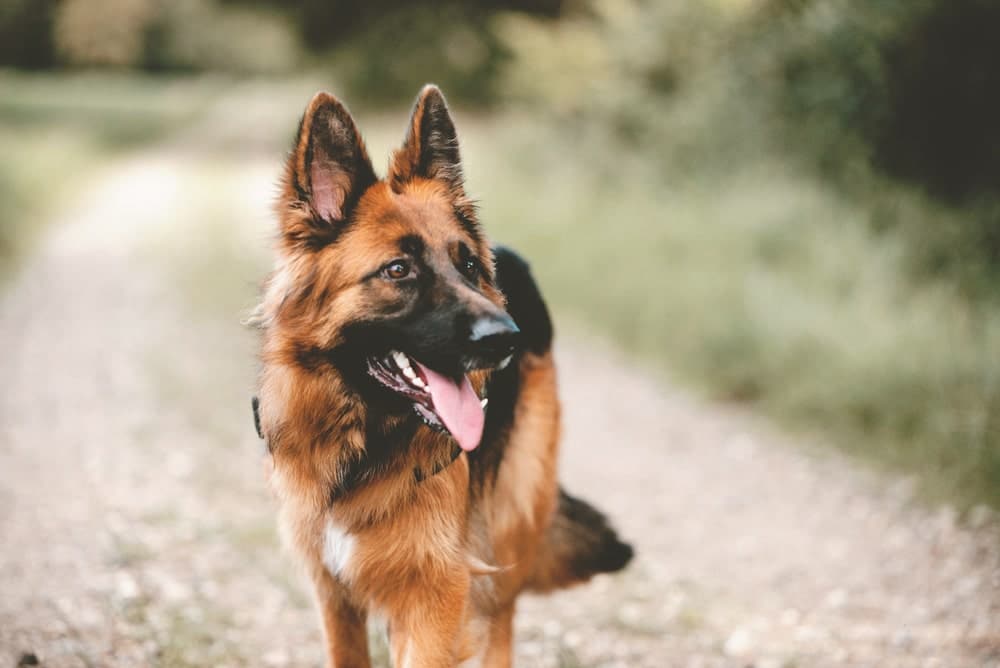
Life Expectancy: 9-13 years
Suitable for Indian Climate: Yes
Height: 23 to 26 inches
Weight: 30-40 kg
The dog had to be strong, powerful, and easy to manage. The dog also had to live peacefully in urban conditions.
The German Shepherd is a large dog with a strong skeleton and a developed muscular build.
The German Shepherd’s coat is short and thick, with a developed undercoat allowing it to endure even frosts.
These dogs get along well with children and other animals, provided their first acquaintance occurred in puppyhood.
They need to be brushed 3-4 times a week.
It should be super premium if you decide to feed your dog dry professional food.
Often, these dogs suffer from hip dysplasia, and many of them are already born with this disease.
16. Doberman Pinscher
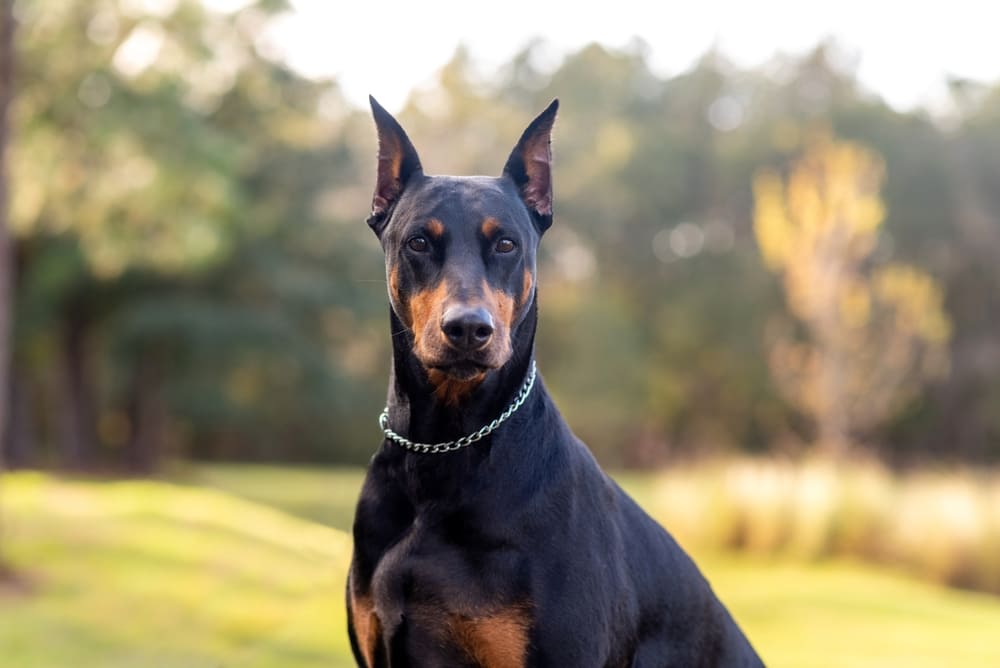
Life Expectancy: 8 – 12 years
Suitable for Indian Climate: Yes
Height: 24 to 28 inches
Weight: 32 – 45 kg
These graceful and strong dogs were bred in Germany in the 1880s.
The Doberman is friendly and gets along well with children, cats, and other pets. He is fearless and will easily give his life to his owners.
Doberman needs to be cleaned daily due to his short and smooth hair, and he does not have the specific odors characteristic of other breeds. It is easy to keep him in a small apartment, but a special place for walking is required.
17. Golden Retriever
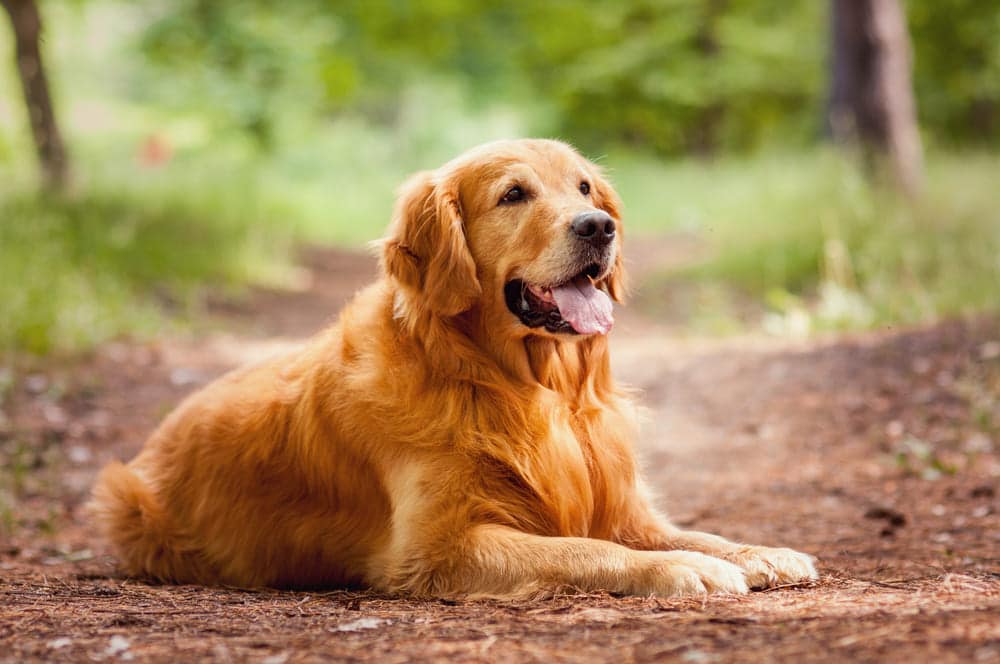
Life Expectancy: 11 to 13 years
Suitable for Indian Climate: Yes
Height: 22 to 24 inches
Weight: 26–41.5 kg
The breed was bred in Great Britain just over 100 years ago as a hunting dog, whose task was to find and bring game to the hunter, often from water bodies.
Golden retrievers are indeed family dogs, accepting all family members and loving children. The Golden Retriever is a gentle dog with a calm character.
Initially, Golden Retrievers were bred for hunting, but now they have become family dogs, guide dogs, and companions.
Golden Retrievers are very good-natured and loyal dogs that cannot imagine life without their owner.
Retrievers often shed, so the dog needs to be combed. Showdaily dogs must also be trimmed regularly.
Claws need to be trimmed regularly, about once every two weeks.
As for the Golden’s diet, you can feed it both professional dry super premium food for large breeds and “natural” food.
Retrievers are one of the healthiest dog breeds. But they often have elbow dysplasia and food allergies.
18. Great Dane
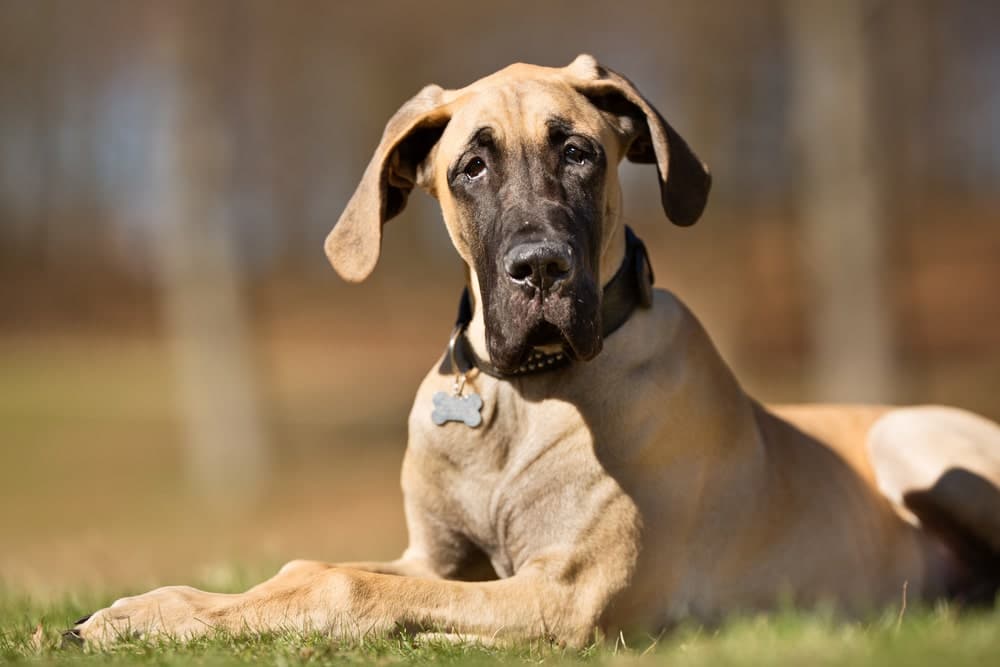
Life Expectancy: 7 to 8 years
Suitable for Indian Climate: Yes
Height: 29 to 34 inches
Weight: 54 to 80 kg
Great Dane is a giant-sized dog breed with versatile working qualities. In the past, it was used for hunting, service, and security purposes.
Nowadays, it remains an excellent guard and bodyguard for its owner but is mainly known as the kindest and most sympathetic family pet in the world.
The Great Dane is not typically angry with a person, except in cases where the dog has been provoked, or the owner is in real danger.
The colors of the Great Dane can be fawn, brindle, marble, black, blue, and mantle.
Caring for a Great Dane involves mandatory care of the claws. The dog’s claws need regular trimming so that it does not feel discomfort or pain when walking.
Great Danes are prone to colds in the cold season, so you should not leave them outside for a long time in cold climates.
19. Siberian Husky
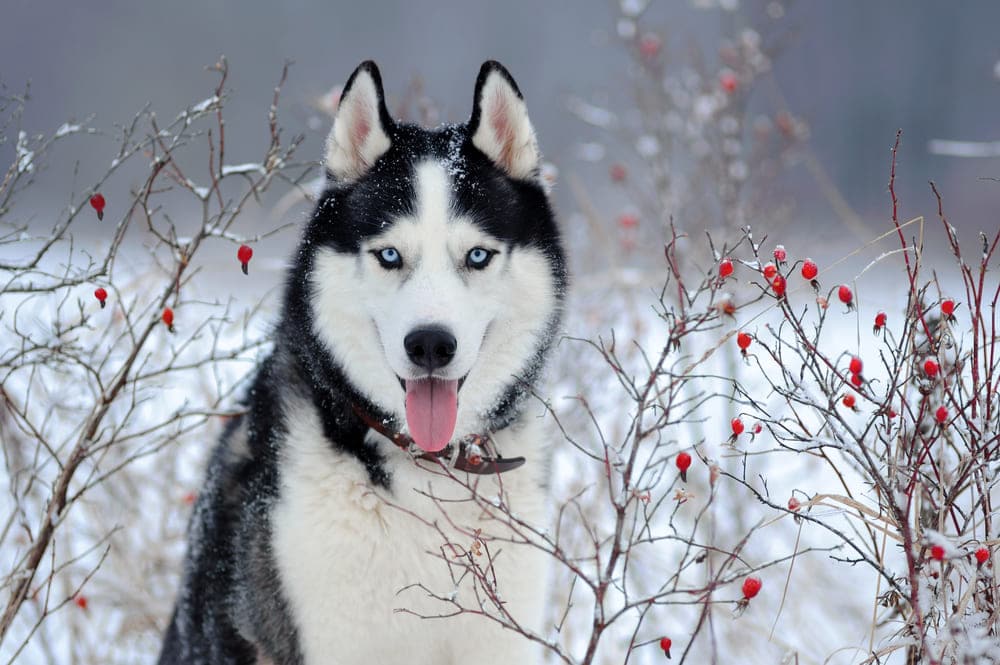
Life Expectancy: 12 to 15 years
Suitable for Indian Climate: Yes
Height: 19 to 24 inches
Weight: 15.5 to 28 kg
The Siberian Husky is a dog that has lived alongside humans for centuries. It was bred by the indigenous people of the Russian Far North.
The health and life expectancy of the Siberian Husky are high. This is explained by the small amount of human intervention in breeding the breed.
Most experts agree that feeding your four-legged friend with dry food and exceptional canned food is better. This must be premium and super-premium products.
20. Beagles
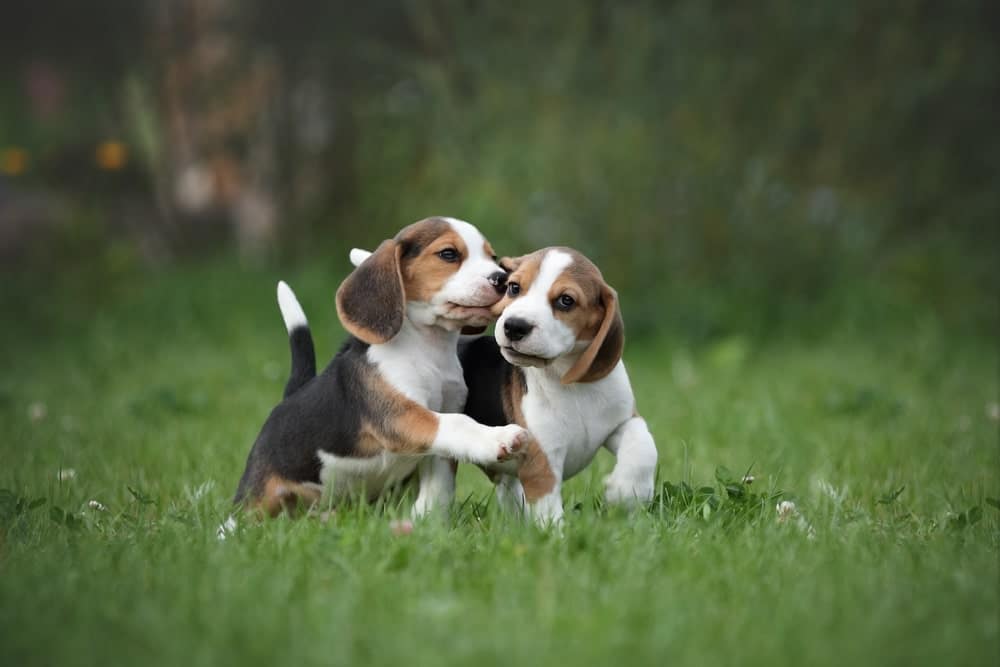
Life Expectancy: 11-15 years
Suitable for Indian Climate: Yes
Height: 12 to 24 inches
Weight: 8-18 kg
Beagles are cheerful and curious and enjoy exploring all the cracks in the house or yard. They are delighted to learn new things.
They enjoy playing with children of all ages.
The dog actively sheds in the spring and fall; during this period, it is combed daily for at least 10 minutes.
The dog is bathed as it gets dirty or once every six months.
Beagles are real gluttons, and they are prone to gaining excess weight. For this reason, the owner must strictly monitor their diet.
Beagles have reasonably good health; the dog will live to a ripe old age with proper care.
21. Bulldog

Life Expectancy: 8-9 years
Suitable for Indian Climate: Yes
Height: 14 to 18 inches
Weight: 20-25 kg
The English Bulldog is a squat breed of medium size with a massive head and a small pelvis.
English Bulldogs are believed to have common roots with the mastiff-like dogs of the Caucasus, ancient Roman mastiffs, Molossian dogs from Greece, and Celtic guard dogs.
Dogs of this breed are intelligent, easy to train, and active but often lazy and love to sleep.
Wash as it gets dirty, wipe the coat with wet wipes, and comb it with a brush. It is necessary to monitor the cleanliness of the eyes and ears.
English bulldogs may be genetically predisposed to elbow and hip dysplasia.
22. Chihuahua
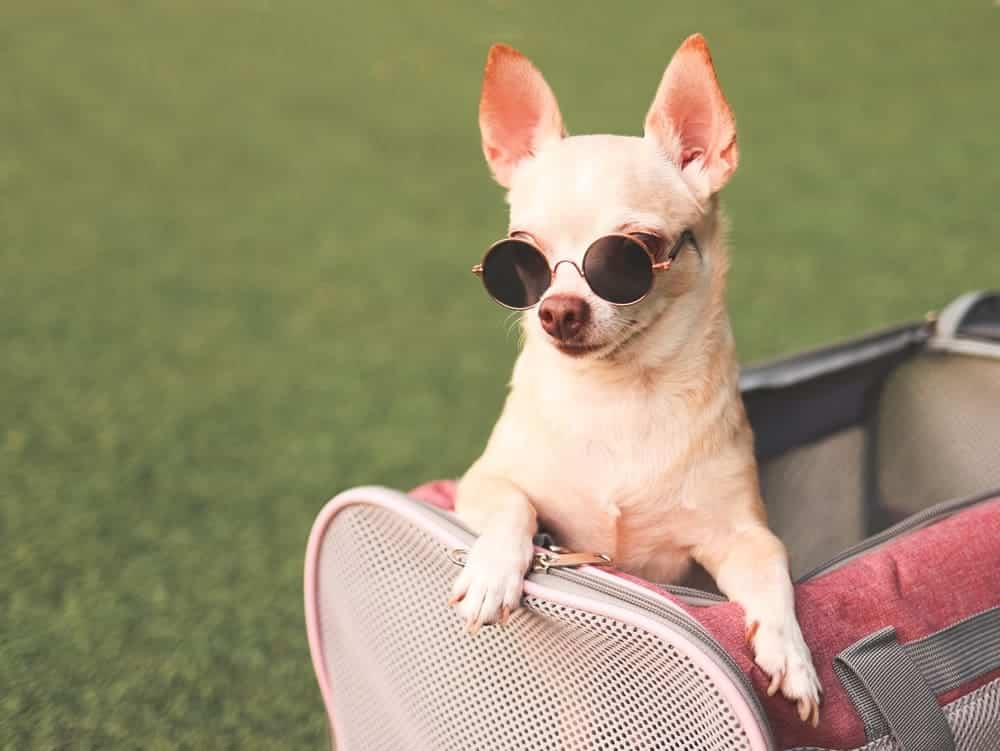
Life Expectancy: 11-14 years
Suitable for Indian Climate: Yes
Height: 5 to 8 inches
Weight: 0.5-3 kg
Chihuahuas are tiny dogs, favorites of public figures, and stars of photo shoots. Their miniature size makes them easy to transport and take with you.
Each tiny Chihuahua is unique in its character, but the general features inherent in the breed can be traced in all its representatives.
Chihuahuas are balanced, proud, and self-loving, which even looks a little funny with their size.
If you decide to feed your Chihuahua natural food, then the basis of the diet should be lean meats and poultry.
Claws are cut once every couple of weeks. Ears and eyes are wiped every day. Teeth require careful monitoring.
Chihuahuas’ coats do not require special care, haircuts, or grooming. Long-haired Chihuahuas are regularly combed to avoid felting.
23. Lhasa Apso

Life Expectancy: 12 to 14 years
Suitable for Indian Climate: Yes
Height: 9 to 12 inches
Weight: 6 to 8 kg
The Lhasa Apso is a friendly and sociable dog with an independent character. Despite its small size, it imagines itself as an essential dog with great physical strength that can protect its owner and family members.
Lhaso Apso has an average energy level, which is perfect for an apartment. Short walks with moderately active games are enough to maintain the pet’s physical and psychological health.
The pet is fed premium industrial dry food and higher or homemade food. Lhasa Apso has satisfactory health; with proper care, they practically
do not get sick.
24. Pug

Life Expectancy: 13 – 15 years
Suitable for Indian Climate: Yes
Height: 9 to 12 inches
Weight: 6.3 – 8.1 kg
Pugs are bright representatives of the Asian type. Most scientists agree that their ancestors, similar to the Pekingese, were bred in China more than 3 thousand years ago.
Pug dogs are calm and balanced. Partly for this reason, many people think that they are lazy. But in fact, pugs copy the habits of their owner.
Pugs get along well with other pets and quickly adapt to other dogs on the street.
Pugs are dogs with a double type of coat and pronounced seasonal shedding. Therefore, they will have to be combed often.
Pugs are far from the healthiest dogs. The most serious of the first category are encephalitis, the cause of which has not yet been fully clarified by veterinarians, and epilepsy.
25. Pomeranian

Life Expectancy: 12-15 years
Suitable for Indian Climate: Yes
Height: 8 to 11 inches
Weight: 2-3 kg
The Pomeranian Spitz is one of the most popular decorative breeds on the planet. It is a funny and active ball of fur and an endless source of positivity, sincere dog loyalty, and courage. This little bear cub is an excellent companion and best friend of the family.
Like other indoor companions, Pomeranians bark a lot, which initially causes unreal trouble for household members and neighbors.
Almost all of their serious diseases are genetic in nature. Still, if the owner regularly takes the pet to the veterinarian and periodically gives the necessary medications, there will be no complications.
Brushing is necessary, if not daily, at least once every 3-4 days, with metal brushes and latex gloves.
It is necessary to feed the Pomeranian Spitz a strictly selected diet; it is better if a veterinarian takes part in its formation.
26. Shih Tzu

Life Expectancy: 11-16 years
Suitable for Indian Climate: Yes
Height: 8 to 11 inches
Weight: 4.5–8.1 kg
The Shih Tzu is believed to be one of the most ancient breeds on earth, and its genotype is closest to that of the wolf.
It can be assumed that the modern Shih Tzu was bred by crossing the Lhasa Apso and the Pekingese. However, there is no unambiguous confirmation of this conclusion.
Shih Tzu is a cheerful, friendly, and docile pet that follows its owner everywhere. The animal is easy to contact, moderately playful, and does not require long, exhausting walks.
For feeding Shih Tzu, use industrial feeds that are at least premium class or holistic feeds for small breeds with medium or low activity.
Grooming is carried out as needed.
The eyes are examined and cleaned daily with a cotton pad or a sterile napkin.
27. Dachshund

Life Expectancy: 12 to 16 years
Suitable for Indian Climate: Yes
Height: 7 to 10 inches
Weight: 7 to 9 kg
Dachshunds are an ancient breed. Small, short-legged dogs were depicted in ancient Egyptian papyri.
Despite their miniature appearance, these dogs have a pronounced sense of self-worth, courage, independence, and ingenuity. Dachshunds rarely react aggressively to strangers and other dogs.
Dachshunds are owners of good health. Diseases usually develop with improper care. Most often, dachshunds can have problems with the digestive system if the owners often overfeed their pets.
With proper care, most diseases can be prevented. Monitoring the dog’s behavior, appetite, activity, and mood is necessary.
28. Indies

Life Expectancy: 12 to 16 years
Suitable for Indian Climate: Yes
Height: 18 to 24 inches
Weight: 11 to 27 kg
Indie dogs can be as affectionate and lovely as any other breed of dog. Indie dogs fiercely defend their families and packs. Indie dogs not only make excellent companion animals.
Indie dogs are highly talkative and intelligent by nature. They can also get along well with other dogs if correctly socialized.
Regular brushing reduces shedding, keeps the coat of your indies healthy overall, and keeps fleas and ticks away.


